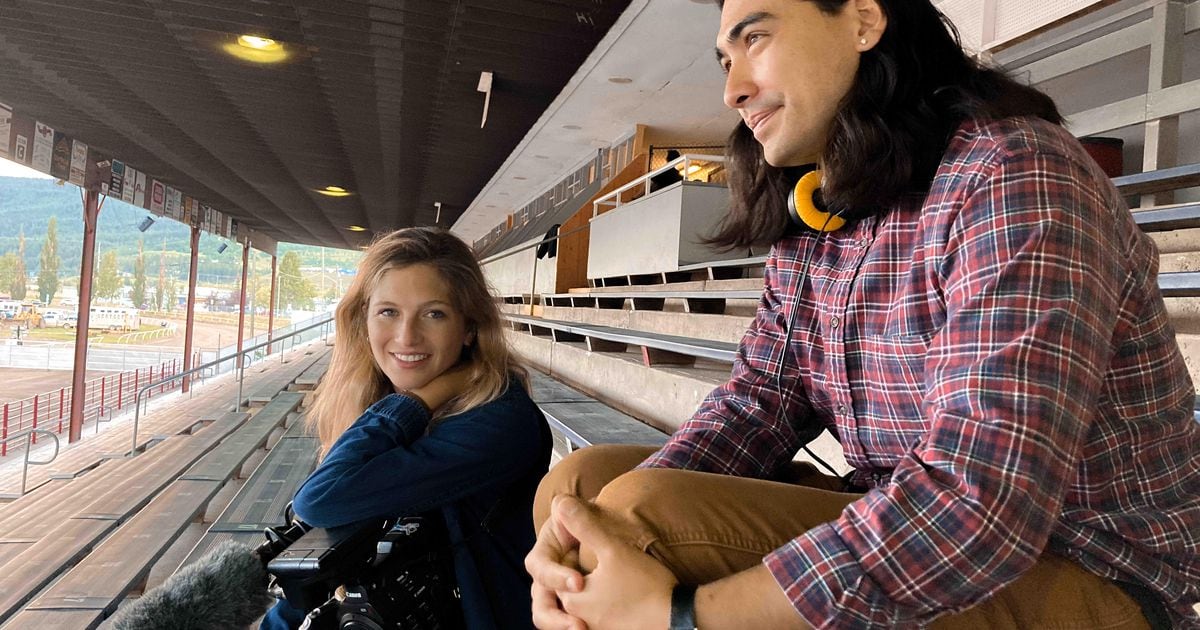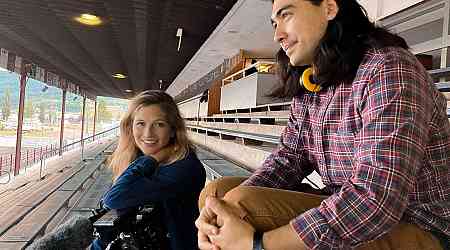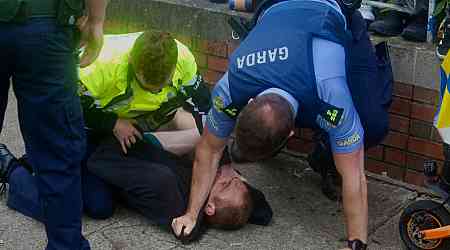Editor’s note • This story includes descriptions of abuse of Indigenous children and families, at the hands of boarding school administrators.
For Julian Brave NoiseCat, “Sugarcane,” his first film as a director, is incredibly personal.
“The film came together in a really interesting, maybe even fortuitous way,” said NoiseCat, who is an enrolled member of the Canim Lake Band Tsq’secen of the Secwepemc Nation in the Canadian province of British Columbia.
“Sugarcane” is an investigative documentary, co-directed by NoiseCat and Emily Kassie, that looks into abuse, neglect and missing children at an Indigenous residential boarding school — St. Joseph’s Mission — near the Williams Lake First Nation Reserve, also known as Sugarcane Reserve, in British Columbia.
It’s the same school members of NoiseCat’s family, notably his grandmother, attended. His father, Ed Archie, was born at the school.
“Sugarcane” — which premiered at the 2024 Sundance Film Festival in January, and won NoiseCat and Kassie the Directing Award for U.S. documentaries — will have a free screening Saturday, July 20, at 5:30 p.m., at the Megaplex Theatres at Valley Fair, 3601 S. 2400 West, West Valley City.
It’s screening as part of the Sundance Institute’s Local Lens program, featuring free screenings Wednesday through next Sunday at locations in Salt Lake City, West Valley City and Park City.
The movie, which was picked up for distribution by National Geographic Documentary Films, will be released in U.S. theaters on Aug. 9, through Variance Films. It will stream later this year on Hulu and Disney+.
Colleagues become collaborators
Where the story of the documentary starts, though, depends on who you ask, NoiseCat said. It could start with his father’s birth. It could start with Kassie’s intention to make a documentary.
NoiseCat said that, for him, it started about a decade ago — when he and Kassie sat next to each other during their first reporting jobs. Kassie, now a Peabody- and Emmy-nominated investigative journalist, was creative director for Highline, a digital magazine from The Huffington Post; NoiseCat was the Native Issues fellow, the first and only person to exclusively cover Indian Country for the publication, he said.
The pair kept in touch after that, NoiseCat said. In May 2021, when news of a mass unmarked grave containing the remains of 215 children at Kamloops Indian Residential School in British Columbia broke, Kassie reached out to NoiseCat about collaborating on a documentary.

The U.S. Department of the Interior, led by Secretary Deb Haaland, reported that year there were 408 of these schools across 37 states. There were eight such schools in Utah.
At these Utah schools, students were forcibly removed hundreds of miles away from their homes and families, and stripped of their culture. Dozens in Utah died. As in Canada, bodies of children have also been found at former school sites in Utah.
In 2021, Haaland unveiled the Federal Indian Boarding School Initiative, “a comprehensive review of the troubled legacy of federal boarding school policies.” The history and lasting impact of those schools remain prevalent in Indigenous families across generations.
When Kassie reached out to NoiseCat, he said he had just signed a book deal.
“I had never written a book before, and I had never made a film and so doing both at the same time felt kind of irresponsible,” NoiseCat said. “More to the point, my family’s connection to the Indian residential schools is very intense and not something that we talked about. So making a documentary about that subject felt like a lot to take on.”
NoiseCat said he thought about Kassie’s idea for a few weeks. He talked to his mother and others about what he should do, and decided to take a leap. When they got back in touch, NoiseCat said Kassie told him she had contacted a chief of a First Nation — Willie Sellers of Williams Lake.
Then, she told him the Williams Lake First Nation was looking into investigating St. Joseph’s Mission.
“There’s a long pause on the phone and then I said, ‘Wow, that’s crazy,’” NoiseCat said. Out of the 139 potential schools in Canada, Kassie has chosen the one school to which NoiseCat’s family had been sent.

An untold family history
As they began working on the documentary, NoiseCat learned more about his family members’ experiences at St. Joseph’s that he didn’t know before — particularly, his father’s background.
“I did not know the story of my father’s birth,” NoiseCat said. “I had some vague notion that he was born in Williams Lake, and I heard that he was found in a dumpster, but that was all he knew. That was all I knew.”
The film — in rich and often horrifying detail, through investigative work and first-person accounts — captures the rampant atrocities committed at St. Joseph’s.
Survivors detail witnessing or experiencing physical and sexual abuse — and how some, like Ed Archie, were born out of such circumstances. “Sugarcane” also uncovers an horrific pattern of infanticide at St. Joseph’s. The film suggests that Ed Archie is the only known survivor of an incinerator at the school.

“One of the core ideas that I wanted to convey through this documentary was the truth that I saw in my own family, in my own community, which is that this horrible thing happened and we rarely ever talked about it,” NoiseCat said.
When news of the atrocities at Indigenous boarding schools started spreading widely in 2021, NoiseCat said he saw a common refrain: that people of the First Nations have been talking about it all along.
“I was, like, ‘Well, that’s really not what I see happening,’” he said. “I still don’t even know all the things that my own grandmother went through at St. Joseph’s Mission and Kamloops residential school, because she still to this day does not talk about them except for in very indirect, cryptic ways.”
It’s a motif that’s prevalent in “Sugarcane” — the lack of conversation about these events. In NoiseCat’s family, it’s examined through the lens of three generations.

That was, NoiseCat said, “core to what we wanted to take apart and sort through: what happens when people finally talk about and find the truth that has been long buried in their own lives and families?”
NoiseCat noted that the “living memory” of the schools resides with the oldest generations of Indigenous people. While it’s incredibly difficult to discuss and hear about, he said, recording and documenting that history is important.
“The point is that if you’re looking in the ground, if you’re solely looking at the past, you’re missing a story,” he said.
While making the documentary, NoiseCat said, he has attended 10 funerals, including that of one of the subjects of the film, Rick Gilbert, former chief of Williams Lake First Nation. Kassie dedicated their Sundance award win to Gilbert who, she said, “went all the way to the Vatican to confront the priest of the Catholic order who abused him.”
NoiseCat said, “In that way, even though we did not, in my father’s instance, get all the answers that we were looking for, we at the very least had those conversations — and then we’re able to find some peace and some closure, dealing with each other across generations because we made the effort.”

‘This is my story’
NoiseCat said everywhere they take the documentary, inevitably someone in the audience stands up and says “something to the effect of, ‘This is my story.’”
In Canada, he said, a truth and reconciliation process is ongoing. In the United States, the case is different.
“It’s not something that we talk about, particularly here in the United States, [where] there were over three times as many Native American boarding schools,” NoiseCat said. Lack of education on boarding schools, he said, is outrageous, adding, “this is a foundational story to North America.”
NoiseCat said he hopes the ongoing “cultural renaissance in Native art and filmmaking” will help change that.
The most special thing about working on this documentary, NoiseCat said, is doing it as an Indigenous storyteller and filmmaker.

“This is really profound when you think about it, from an Indigenous point of view, we actually get to live our stories,” he said. “The stories that we choose to tell are ones that we choose to witness or ones that we choose to be a part of.”
For him, that meant choosing to live his life in a purposeful way during a moment of reckoning for his family.
“I was speaking my language a lot more often, participating in a ceremonial life with my community, taking on certain responsibilities and obligations to my people and my ancestors, and the generations that are coming after me,” he said. “That was truly transformative for me … that was exactly what these schools were designed to destroy. In a very roundabout way, this film brought me back to that.”
NoiseCat said he hopes that people who watch “Sugarcane” remember that “this is not history. This is right now. This is life or death.”
“Sugarcane” ends with a number of statistics shown on screen. One of the last lines, which NoiseCat wrote, reads, “Indigenous people are still dying from residential boarding schools. And still living, despite them.”
That duality, of Indigenous people continuing to exist while “being nearly annihilated” is, NoiseCat said, “the story of the school and of our people.”
Editor’s note • Native leaders have called for additional mental health support as Indigenous communities learn more about this history of boarding schools. The Urban Indian Center of Salt Lake provides outpatient mental health services; learn more at uicls.org. Learn about services of the Utah Navajo Health System at unhsinc.org. Find the Tribal Resource Tool at tribalresourcetool.org.
function onSignUp() { const token = grecaptcha.getResponse(); if (!token) { alert("Please verify the reCAPTCHA!"); } else { axios .post( "https://8c0ug47jei.execute-api.us-east-1.amazonaws.com/dev/newsletter/checkCaptcha", { token, env: "PROD", } ) .then(({ data: { message } }) => { console.log(message); if (message === "Human
























